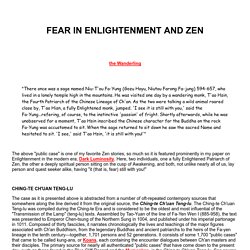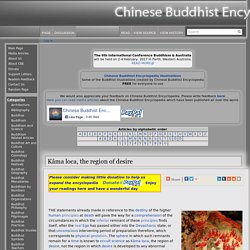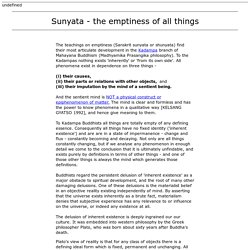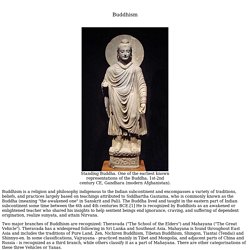

Esoteric Buddhism and the Tantras in East Asia.pdf. (2) The Tibetan Book Of Living And Dying. (Complete) What Japanese Do Not Want Black People To Know About Buddhism. (8) Tibetan Buddhism: Secrets of the Yogis of Tibet - Part 5. Introduction to Tibetan Buddhism (article) Satori in Zen Buddhhism. SOURCES Santina, Peter Della, AN INTRODUCTION TO MAJOR TRADITIONS OF BUDDHISM, Chico Dharma Study Group.

Eastman, Roger, ed. THE WAYS OF RELIGION. New York: Oxford University Press, 1993. Prebish, Charles, S., ed. BUDDHISM: A MODERN PERSPECTIVE. "Once a man has come to know Him (the great unborn Atman), he becomes a muni. It should be noted that the aforementioned tradition of wandering monks (parivrajaka) continued from its original roots through to Buddhism and on to Zen. "This article was posted and garnered responses from several readers. Fear in Enlightenment and Zen. "There once was a sage named Niu-T'ou Fa-Yung (Gozu Hoyu, Niutou Farong Fa-jung) 594-657, who lived in a lonely temple high in the mountains.

He was visited one day by a wandering monk, T'ao Hsin, the Fourth Patriarch of the Chinese Lineage of Ch'an. As the two were talking a wild animal roared close by, T'ao Hisn, a fully Enlightened monk, jumped. 'I see it is still with you,' said the Fa-Yung...refering, of course, to the instinctive 'passion' of fright. Shortly afterwards, while he was unobserved for a moment, T'ao Hsin inscribed the Chinese character for the Buddha on the rock Fa-Yung was accustomed to sit. When the sage returned to sit down he saw the sacred Name and hesitated to sit.
Kâma loca, the region of desire - Chinese Buddhist Encyclopedia. THE statements already made in reference to the destiny of the higher human principles at death will pave the way for a comprehension of the circumstances in which the inferior remnant of these principles finds itself, after the real Ego has passed either into the Devachanic state, or that unconscious intervening period of preparation therefore, which corresponds to physical gestation.

The sphere in which such remnants remain for a time is known to occult science as Kâma loca, the region of desire, not the region in which desire is developed to any abnormal degree of intensity, as compared with desire as it attaches to earth life, but the sphere in which that sensation of desire, which is a part of the earth life, is capable of surviving. It is not in the grave, however, that this fourth principle can be put away. It is not spiritual in its nature or affinities, but it is not physical in its nature. Yuli the holy book433. Six Yogas of Naropa - Wikipedia. The Six Yogas of Nāropa (Wylie: na ro'i chos drug), also called the six dharmas of Naropa,[1] are a set of advanced Tibetan Buddhist tantric practices and a meditation sādhanā compiled in and around the time of the Indian monk and mystic Nāropa (1016-1100 CE) and conveyed to his student Marpa Lotsawa.

The six yogas were intended in part to help in the attainment of Buddhahood in an accelerated manner. Six Yogas or Six Dharmas? [edit] Peter Alan Roberts notes that the proper terminology is "six Dharmas of Nāropa", not "six yogas of Nāropa": "Tilopa briefly described these six practices in a short verse text entitled Instructions on the Six Dharmas. Classification[edit] What Buddhists Believe - The Noble Eightfold Path - The Middle Way. This is the Path for leading a religious life without going to extremes.

An outstanding aspect of the Buddha's Teaching is the adoption of the Eightfold Path is the Middle Path. The Buddha advised His followers to follow this Path so as to avoid the extremes of sensual pleasures and self-mortification. Zen Quotes - a collection of Quotes from Zen Teachers. Shunryu Suzuki Roshi was one of the most influential teachers of Soto Zen Buddhism in American history.

Zen Buddhism was transmitted from China to Japan in the twelfth century, and was distinguished by the direct transmission of profound insight into the nature of Reality, from master to disciple, rather than through reliance on words and scriptures. Tibetan Buddhism - Nangten Menlang International. Buddhism is a method for coming to know our deep, inner nature, which is wisdom.

With this kind of wisdom, we can achieve unchangeable happiness. Buddhist philosophy and Sunyata - the emptiness of all things. The teachings on emptiness (Sanskrit sunyata or shunyata) find their most articulate development in the Kadampa branch of Mahayana Buddhism (Madhyamika Prasangika philosophy).

To the Kadampas nothing exists 'inherently' or 'from its own side'. All phenomena exist in dependence on three things - (i) their causes, (ii) their parts or relations with other objects, and (iii) their imputation by the mind of a sentient being. And the sentient mind is NOT a physical construct or epiphenomenon of matter. The mind is clear and formless and has the power to know phenomena in a qualitative way [KELSANG GYATSO 1992], and hence give meaning to them.
To Kadampa Buddhists all things are totally empty of any defining essence. Buddhists regard the persistent delusion of 'inherent existence' as a major obstacle to spiritual development, and the root of many other damaging delusions. Chinese Buddhist Encyclopedia. Two people from Buddhism & Australia, Vello Vaartnou and Marju Broder represented Australia at the UC Berkeley PNC conference that was held on 16-18 August, 2016 in Los Angeles.

The PNC was founded at the University of California, Berkeley and it encourages scholars, academic institutions, and universities to collaborate and exchange their academic resources and research expertise. It is really wonderful, that Western Australia which is usually known for the mining boom, was represented by two people who deal with the academic aspect of Buddhism on international level.
Until today, Western Australian universities do not have Buddhist studies at all. Buddhism. Buddhism Standing Buddha.

Fundamental Buddhism. 1. Mahayana Buddhism. 1. Fundamental Philosophical Tenets Common to All Forms of Mahayana Buddhism 1.1. The Ideal of the Bodhisattva 1.2. Emptiness (Sunyata) 1.2.1. Introduction 1.2.2. Ch'an Buddhism. The Ch'in dynasty gave way to the Han dynasty, which lasted from 202 BCE to 220 CE; it was a period of prosperity and stability in Chinese history. During this time the Great Wall of China was extended (it was built in the Ch'in dynasty to keep the less-civilized, nomadic tribes of central Asia out of China).
Intellectually this period was conservative, unlike the period of the hundred philosophers. During this time Confucianism dominated the social and religious life of the people; it provided a basis for social structure that encouraged stability and unity. Taosim still survived in this period in both its philosophical form and in what we could call its populist religious form. Food - What dietary practices are most helpful for reaching enlightenment? - Buddhism Stack Exchange. As far as dietary guidelines for Enlightenment, I really like the "Three Gunas" model. I feel many people these days lack fundamental intuition for what constitutes good or bad energy when it comes to eating. The Three Gunas model provides a set of guidelines that people can follow until they develop an intuitive feel for healthy eating.
In their simplest form, the three gunas can be defined as: Tamas, the abstract energy of stagnation, ignorance, stupor.Rajas, the abstract energy of passion, aggression, impulsion.Sattva, the abstract energy of purity. In context of the diet, these translate to: Tamas: food that is not fresh, or has tatty/grubby/frowsy atmosphere about it.Rajas: Food that stimulates primitive senses with crude strong flavors.Sattva: Simple, ascetic food.
Concept & Reality 1.4—Apophatic Periphraxis. Apophatic Periphraxis: Nibbāna the Inexpressible Please see the full documentation Apophasis means talking about a subject that remains tacit, unspoken.Periphraxis refers to circumlocution, indirection or euphemism.An example of apophasis is the KITE essay.An example of periphaxis is a woman complaining that she ‘doesn’t have anything to wear,’ when her real concern is that her wardrobe makes her look fat. Another example of both apophasis and periphraxis is this series: if you haven’t watched our previous videos, especially Matrix Learning, Apophatic Antifragility and the previous videos in this series, much of what we say here won’t make sense. That is because this video treats that material as apophatic, and you lack the required background and context.
Similarly, discussions of the Buddha’s teaching also will not make much sense unless you read, study and practice the Theravāda Suttas, which are themselves apophatic with regard to nibbāna. From Concept and Reality: Sent from my iPad. Sacred Texts: Buddhism. Sacred-texts home Journal Articles: Buddhism OCRT: Buddhism Buy CD-ROM Buy Books about Buddhism Modern works Southern Buddhism Northern Buddhism JatakaLinks Modern works. The Buddha and the Middle Way. Buddhism and The Kalachakra System - Buddhismo y El Sistema Kalachakra. The Tibetan Book of the Dead. An Expanded View Originally written June 1970 Edited November 2000 Redited March 2009 Introduction. The Tibetan Book of the Dead: Transitions to the Otherworld. Several days after the visions of the Peaceful and Wrathful Deities have subsided, the deceased acquires a mental body complete with all five senses, enters the "Bardo of Becoming" or Sipa Bardo (srid pa bar do), and begins his or her descent to a new birth.